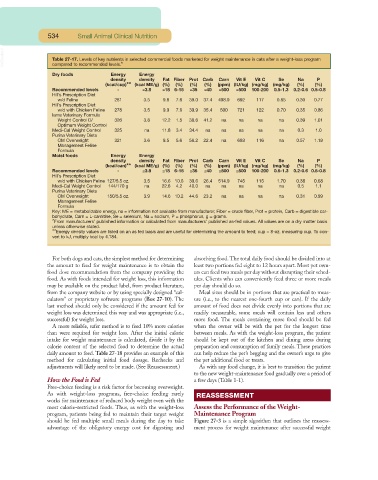Page 518 - Small Animal Clinical Nutrition 5th Edition
P. 518
534 Small Animal Clinical Nutrition
VetBooks.ir Table 27-17. Levels of key nutrients in selected commercial foods marketed for weight maintenance in cats after a weight-loss program
compared to recommended levels.*
Dry foods Energy Energy
density density Fat Fiber Prot Carb Carn Vit E Vit C Se Na P
(kcal/cup)** (kcal ME/g) (%) (%) (%) (%) (ppm) (IU/kg) (mg/kg) (mg/kg) (%) (%)
Recommended levels - ≤3.8 ≤18 6-15 ≥35 ≤40 ≥500 ≥500 100-200 0.5-1.3 0.2-0.6 0.5-0.8
Hill’s Prescription Diet
w/d Feline 281 3.5 9.8 7.6 39.0 37.4 498.9 692 117 0.85 0.30 0.77
Hill’s Prescription Diet
w/d with Chicken Feline 278 3.5 9.9 7.6 39.9 35.4 500 721 122 0.70 0.35 0.86
Iams Veterinary Formula
Weight Control D/ 326 3.8 12.2 1.5 38.6 41.2 na na na na 0.39 1.01
Optimum Weight Control
Medi-Cal Weight Control 325 na 11.8 3.4 34.4 na na na na na 0.3 1.0
Purina Veterinary Diets
OM Overweight 321 3.6 8.5 5.6 56.2 22.4 na 693 116 na 0.57 1.19
Management Feline
Formula
Moist foods Energy Energy
density density Fat Fiber Prot Carb Carn Vit E Vit C Se Na P
(kcal/can)** (kcal ME/g) (%) (%) (%) (%) (ppm) (IU/kg) (mg/kg) (mg/kg) (%) (%)
Recommended levels - ≤3.8 ≤18 6-15 ≥35 ≤40 ≥500 ≥500 100-200 0.5-1.3 0.2-0.6 0.5-0.8
Hill’s Prescription Diet
w/d with Chicken Feline 127/5.5 oz. 3.5 16.6 10.6 39.6 26.4 514.9 745 115 1.70 0.38 0.68
Medi-Cal Weight Control 144/170 g na 22.6 4.2 40.0 na na na na na 0.5 1.1
Purina Veterinary Diets
OM Overweight 150/5.5 oz. 3.9 14.6 10.2 44.6 23.2 na na na na 0.31 0.99
Management Feline
Formula
Key: ME = metabolizable energy, na = information not available from manufacturer, Fiber = crude fiber, Prot = protein, Carb = digestible car-
bohydrate, Carn = L-carnitine, Se = selenium, Na = sodium, P = phosphorus, g = grams.
*From manufacturers’ published information or calculated from manufacturers’ published as-fed values. All values are on a dry matter basis
unless otherwise stated.
**Energy density values are listed on an as fed basis and are useful for determining the amount to feed; cup = 8-oz. measuring cup. To con-
vert to kJ, multiply kcal by 4.184.
For both dogs and cats, the simplest method for determining absorbing food. The total daily food should be divided into at
the amount to feed for weight maintenance is to obtain the least two portions fed eight to 12 hours apart. Most pet own-
food dose recommendation from the company providing the ers can feed two meals per day without disrupting their sched-
food. As with foods intended for weight loss, this information ules. Clients who can conveniently feed three or more meals
may be available on the product label, from product literature, per day should do so.
from the company website or by using specially designed “cal- Meal sizes should be in portions that are practical to meas-
culators” or proprietary software programs (Box 27-10). The ure (i.e., to the nearest one-fourth cup or can). If the daily
last method should only be considered if the amount fed for amount of food does not divide evenly into portions that are
weight loss was determined this way and was appropriate (i.e., readily measurable, some meals will contain less and others
successful) for weight loss. more food. The meals containing more food should be fed
A more reliable, safer method is to feed 10% more calories when the owner will be with the pet for the longest time
than were required for weight loss. After the initial caloric between meals. As with the weight-loss program, the patient
intake for weight maintenance is calculated, divide it by the should be kept out of the kitchen and dining areas during
calorie content of the selected food to determine the actual preparation and consumption of family meals. These practices
daily amount to feed. Table 27-18 provides an example of this can help reduce the pet’s begging and the owner’s urge to give
method for calculating initial food dosage. Rechecks and the pet additional food or treats.
adjustments will likely need to be made. (See Reassessment.) As with any food change, it is best to transition the patient
to the new weight-maintenance food gradually over a period of
How the Food is Fed a few days (Table 1-1).
Free-choice feeding is a risk factor for becoming overweight.
As with weight-loss programs, free-choice feeding rarely REASSESSMENT
works for maintenance of reduced body weight even with the
most calorie-restricted foods. Thus, as with the weight-loss Assess the Performance of the Weight-
program, patients being fed to maintain their target weight Maintenance Program
should be fed multiple small meals during the day to take Figure 27-3 is a simple algorithm that outlines the reassess-
advantage of the obligatory energy cost for digesting and ment process for weight maintenance after successful weight

